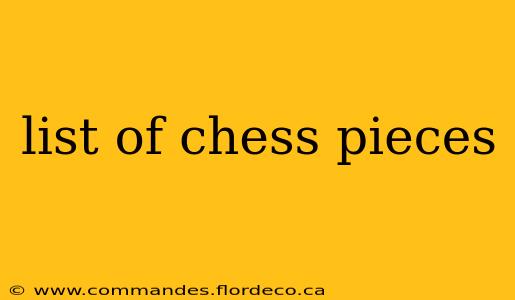Chess, a game of strategy and intellect, boasts a captivating array of pieces, each with unique movement and tactical capabilities. Understanding the role and movement of each piece is crucial to mastering the game. This comprehensive guide will explore each chess piece, providing insights into their strengths, weaknesses, and strategic importance.
The Six Chess Pieces: A Detailed Breakdown
There are six types of pieces in chess, each belonging to either the white or black army:
1. King:
The most important piece on the board, the king's survival is the ultimate objective of the game. Checkmate, the situation where the king is under attack and cannot escape, results in a loss. The king moves only one square in any direction. While seemingly weak, the king's strategic positioning is paramount, particularly in the endgame.
2. Queen:
The most powerful piece, the queen combines the movement capabilities of the rook and the bishop. It can move any number of squares horizontally, vertically, or diagonally. Controlling the center of the board with the queen is a common strategic goal. Its versatility makes it a potent offensive and defensive weapon.
3. Rook:
The rook moves any number of squares horizontally or vertically, but not diagonally. Rooks are particularly powerful in the endgame, where open files (vertical columns) or ranks (horizontal rows) allow them to dominate. They play a key role in controlling the board's edges and are often crucial in delivering checkmate.
4. Bishop:
The bishop moves any number of squares diagonally. Each player starts with one bishop that moves only on light squares and one that moves only on dark squares. This restriction is important strategically, but their diagonal movement makes them effective in controlling diagonals and attacking pieces.
5. Knight:
The knight's movement is unique. It moves in an "L" shape: two squares in one direction (horizontally or vertically), then one square perpendicular to that direction. The knight is the only piece that can "jump" over other pieces, making it invaluable for attacking and maneuvering through congested areas of the board.
6. Pawn:
The pawn is the least powerful piece individually, but its collective strength is considerable. Pawns move one square forward, except for their initial move, where they can move one or two squares forward. They capture diagonally one square forward. Pawns are crucial for controlling space, supporting other pieces, and potentially promoting to more powerful pieces upon reaching the opposite end of the board.
Frequently Asked Questions about Chess Pieces
What is the strongest chess piece?
The queen is generally considered the strongest chess piece due to its combined movement capabilities, offering the greatest versatility and attacking potential.
Which chess piece can jump over other pieces?
Only the knight can jump over other pieces, making it uniquely valuable in maneuvering around obstacles on the board.
How many squares can a queen move?
A queen can move any number of squares in any direction (horizontally, vertically, or diagonally), provided its path is unobstructed.
What is the role of a pawn in chess?
Pawns are crucial for controlling space, protecting more valuable pieces, and potentially promoting to more powerful pieces upon reaching the opposite rank. Their collective strength significantly impacts the game's outcome.
Can a bishop move horizontally or vertically?
No, a bishop can only move diagonally. Each player starts with two bishops, one controlling light squares and the other controlling dark squares.
This comprehensive guide offers a thorough overview of the chess pieces. By understanding their individual movements and strategic roles, you’ll significantly enhance your chess skills and game play. Remember, practice and understanding of strategy are key to mastering the game of chess.
